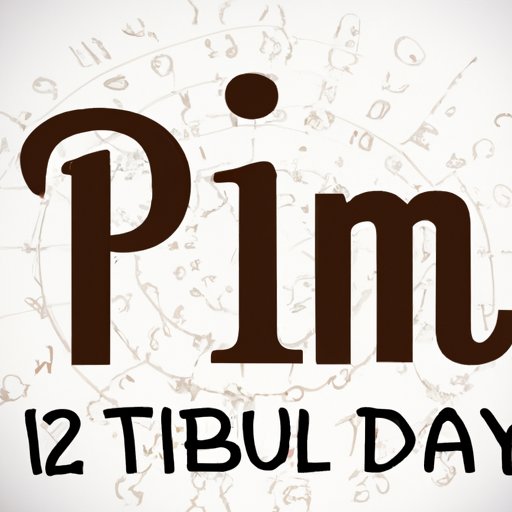I. Introduction
Pi Day is an annual celebration of the mathematical constant π (pi). It is celebrated on March 14th (3/14) because the first three digits of pi are 3.14. Pi Day began as a small gathering of math enthusiasts, but it has since grown into a global phenomenon that includes fun activities, events, and even food. In this article, we will explore the history and significance of Pi Day, discuss the importance of pi in mathematics, provide ideas for fun ways to celebrate this day, and explore how Pi Day is celebrated around the world.
II. History of Pi Day
The concept of Pi Day was first introduced by physicist Larry Shaw in 1988. Shaw, who worked at the Exploratorium in San Francisco, organized a march around the museum to celebrate pi on March 14th. The event included a circular parade and the recitation of pi to as many digits as possible.
The celebration gained popularity within the scientific community and eventually spread to schools, where teachers began incorporating pi-related activities into their lessons. In 2009, the U.S. House of Representatives passed a resolution recognizing March 14th as National Pi Day, and the rest is history.
Today, Pi Day is celebrated in many ways around the world. Some people participate in pi memorization contests, while others bake pi-themed pies or participate in math-themed competitions and challenges.
III. The Importance of Pi in Mathematics
Pi, represented by the Greek letter π, is a mathematical constant that represents the ratio of a circle’s circumference to its diameter. It is approximately equal to 3.14159, but it is an irrational number, meaning that it goes on infinitely without repeating.
Pi is one of the most important mathematical constants, and it appears in countless equations and formulas across a variety of disciplines. For example, pi is used to calculate the area and volume of circles, cylinders, and spheres, as well as in trigonometric functions and statistics.
The significance of pi dates back to ancient times, with the earliest known estimate being from ancient Egypt around 1650 BC. Throughout history, mathematicians have worked to increase our understanding of pi, and it continues to play a vital role in modern mathematics and science.
IV. Fun Ways to Celebrate Pi Day
Pi Day provides an opportunity to embrace the fun side of mathematics and celebrate the significance of pi. Here are just a few ideas for how you can celebrate:
- Bake a pie – whether it’s a classic apple pie or a pie that’s shaped like the pi symbol, baking a pie is a fun and delicious way to celebrate Pi Day.
- Host a math competition – challenge your friends or coworkers to a math competition that includes pi-related questions.
- Create pi-related art – use the numbers of pi to create a unique work of art.
- Watch a movie about mathematics – From “A Beautiful Mind” to “Hidden Figures”, there are many movies that celebrate the beauty of mathematics.
There have been many creative Pi Day celebrations in the past, including musical performances featuring pi-related songs, Pi Day parades, and even the creation of a pi shrine in Tokyo, Japan.
V. How to Calculate Pi
Calculating pi is a complex process that has fascinated mathematicians for centuries. There are several methods used to calculate pi, including:
- Infinite series – series like the Gregory-Leibniz series or the Nilakantha series can be used to calculate pi to a certain number of digits.
- Geometric construction – methods like Archimedes’ method and polygon approximation can be used to calculate pi using only a compass and straightedge.
- Monte Carlo simulation – simulating random points on a plane can help calculate pi to a high degree of accuracy.
Many mathematicians have contributed to our understanding of pi, including Archimedes, who was one of the first to develop a formula for pi, and Ada Lovelace, who was the first person to envision using a computer to calculate pi to an extraordinary number of digits.
VI. Pi Day Celebrations Around the World
Pi Day is celebrated in many countries around the world, and each culture has unique traditions and customs associated with this mathematical holiday. In Japan, some people celebrate Pi Day by eating pie, while in China, pi day is celebrated on July 22nd (22/7) because the fraction 22/7 is often used as an approximation of pi.
In the United States, Pi Day celebrations range from Pi Day-themed marathons to Pi Day scavenger hunts. In South Africa, Pi Day often includes competitions, math-themed lectures, and other activities.
One particularly unique Pi Day celebration occurs in San Francisco, where a group of people run from one pie shop to another, consuming one slice of pie at each stop. This event is known as the Pi Run and has become a popular tradition among San Francisco locals.
VII. Conclusion
March 14th is a day to celebrate all things pi, from its historical significance to its importance in mathematics. Pi Day provides an opportunity to explore the fun side of math and participate in a global celebration that spans cultures and traditions.
Whether you celebrate by baking a pi-themed pie, hosting a math competition, or learning more about the amazing innovations that led to our understanding of pi, there’s no shortage of ways to celebrate Pi Day.
